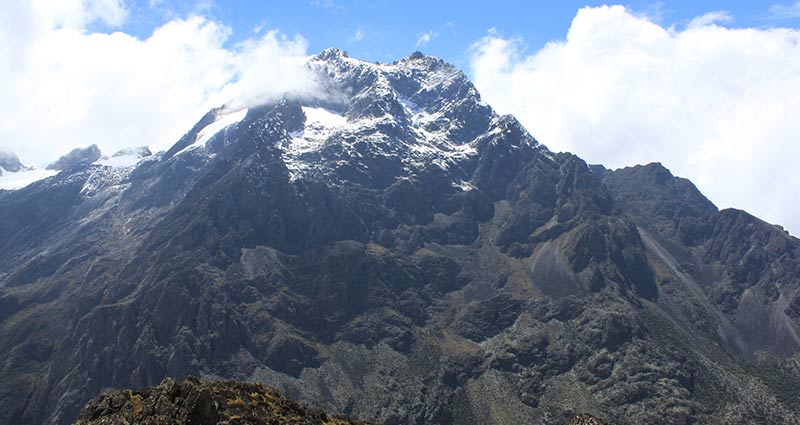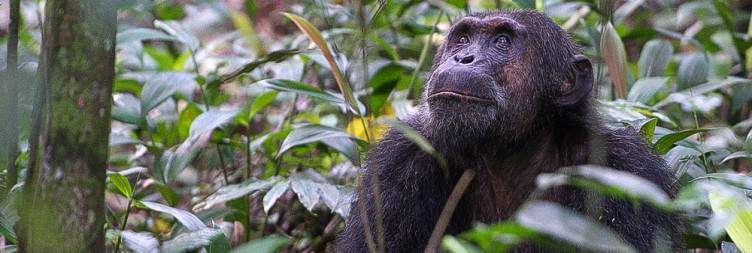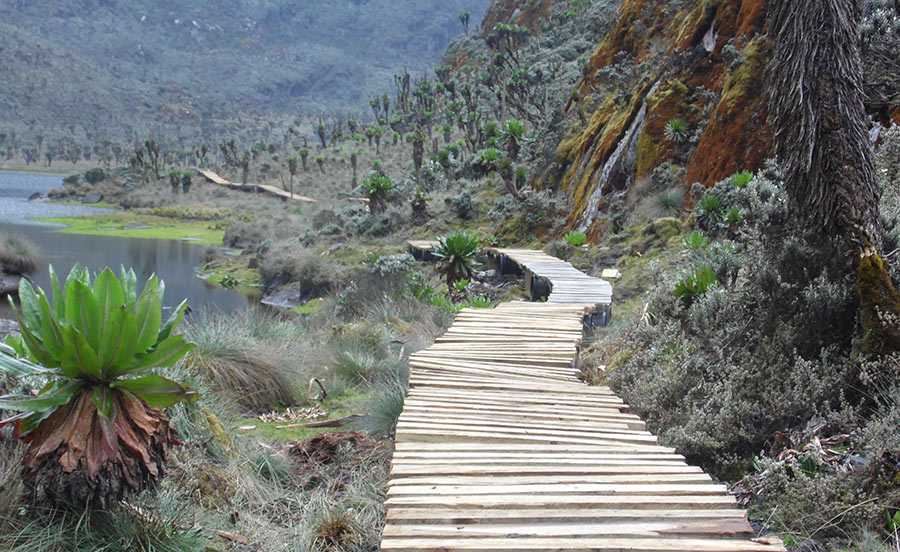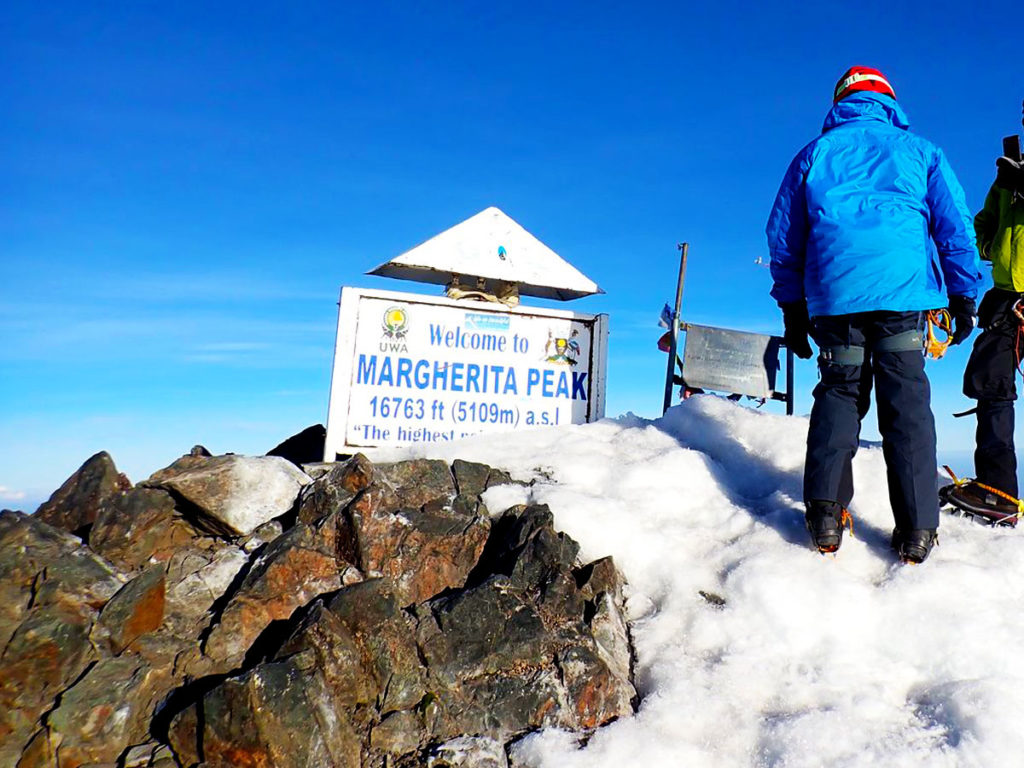Rwenzori Mountains National Park
Rwenzori Mountains National Park was designated a UNESCO World Heritage Site in 1994 because of it’s outstanding natural beauty. The park is almost 1000km² in size and home to about half of Africa’s 10 highest mountain peaks. Africa’s fourth highest peak, Mount Stanley, is the highest, sitting in excess of 5,100m.
The park has glaciers, snowfields, waterfalls, and lakes and is one of Africa’s most beautiful and prominent mountain areas.
Home to many endangered species, and many that are native to the Albertine rift valley, you can find creatures such as forest elephants, chimpanzee, hyrax, black-and-white colobus, duiker, Rwenzori otter, leopard and L’Hoest’s monkeys.
The vegetation can be quite dense so spotting some of the more rare animal species which are here requires some effort but are very rewarding when found.

As well as this, there are 217 bird species, 17 species endemic to the park, which includes: Rwenzori Turaco, Barred Long-tailed Cuckoo, Long-eared Owl, Handsome Francolin and the Cinnamon-chested Bee-eater.
Animal Life at Rwenzori Mountains National Park
The vegetation is thick and it can make it hard to spot some of the more elusive creatures here like colobus and blue monkeys, but you are often rewarded with elephant, chimpanzee, Rwenzori otter and leopard.
On the whole there are 6 Albertine rift valley endemic species here, 3 of which are rare species among the 70 or so species of mammal.

As for birds, there are flycatchers, crimsonwings, Lagden’s bush shrike, slender-billed starling, blue-headed sunbird, golden-winged sunbird, strange weaver, Rwenzori turaco, Barred long-tailed cuckoo and many, many more within the 217 species of birds that call the park home.
Activities and Culture at Rwenzori Mountains National Park
Birding
There are reputedly 217 species of bird that can be found in Rwenzori National Park, 17 of which are endemic to the park making it an important birding area (IBA).
The diversity of birds includes white-starred robin, Rwenzori batis, barred long-tailed cuckoo, long-eared owl, slender-billed starling and blue-headed sunbird, and higher in the slopes, you can view bearded vultures, swifts or black eagles that you may see circling for prey.
Hiking/Nature Trails
The mountains of Rwenzori are also sometimes known as the ‘mountains of the moon’ due to the bizarre and other-worldly nature of the terrain and creatures you can find here.
There are trails up to Lake Mahooma and Buraro chimp forest, walks through the Kichamba communities and hiking to Bundibugo, the central town of the Bundibugyo District.
You can take a 3 day journey around the mountains; meeting the Bakonzo People, taking a secluded and unique hill climb and finally returning to Kampala after a forest walk where you can see the three-horned chameleon and the Ross Turaco, and you can learn how to fish with only your hands!
There is also a more intense 7 day climb for the more mountaineering-minded adventurer called the central circuit trail. You begin at Mihunga and ascend the Bujuku valley and pass through several key passes before descending again in the Mubuku valley. You can also scale the lofty snowy peaks of the mountains here which will reward you with breathtaking views.
Finally, you have the Kilembe Trail hiking the southern slopes of the Rwenzori. This beautiful route along Nyamwamba Valley passes glacial lakes and stunning viewpoints before re-joining the Central Circuit at Lake Kitandara.
Local Culture at Rwenzori Mountains National Park
You can visit the farming town of Ruboni which is home to the mountain keepers, the Bakonzo who number around 2,000. You can walk with them to see their daily routing; from preparing food to animal tending, to enjoying traditional dance and seeing the blacksmith, healers and storytellers of the tribe.
There is also a scenic tour you can take here where you can view the locals working on the land and see some wildlife like Rwenzori turaco, tiny sunbirds, cinnamon-chested Bee-eaters, chameleons, squirrels and vervet monkeys.
On clear days you can even see snow capped Margherita Peak, a remarkable sight.
Alternatively, you can view the Rwenzori Turaco View Camp Site, the tiny Mihunga village where the Bakonzo has lived over 300 years without a source of running water or electricity.
A trip to this village will mean that you can view a demonstration by a traditional healer, whose herb-based concoctions are believed to have a wide range of healing powers. There is also a trip to the village school, a crafts demonstration and a lively dance performance.
Similarly to Ruboni, there is a nature trail here where you can see the local wildlife.
Lastly, you have the Bulemba-Ihandiro cultural trail which is a six or seven hour trail through points of religious significance to the Bakonzo. You can meet the traditional healer, who wields the powers known as muhima and the blacksmith you can explain the significance of the Bakonzo stool.
The trail then goes to the Kamusonge River whose waters are believed to be quick to quench the thirst, before embarking on the final hour-long walk to the museum, thatched in the traditional Konzo style.
On display are implements used during the Rwenzururu struggle, traditional dress and the other items of historical and cultural importance to the people of the Rwenzoris.
Getting there at Rwenzori Mountains National Park
The Rwenzori mountains lie along the Uganda-congo border in western Uganda .the main trailheads are accessed from the tarmac fort portal –kasese ,is 375km from kampala via fort portal (which is 300km from kampala )and 450km passing via mbarara .the kilembe trailheadlies at the head of nyamwamba valley ,15km west of kasese . the central circuit trailhead is located in mubuku vellay at mihunga ,22km from fort portal –kasese road ,25km north of kasese .for the bukurungu trail ,turn off the main road at nyakigumba ,midway between kasese and fort portal ,drive for 6km to the trailhead at katebwa .
Air transport can also be arranged to kasese from kampala(kajjansi) airfield or Entebbe International Airport .
Gallery




